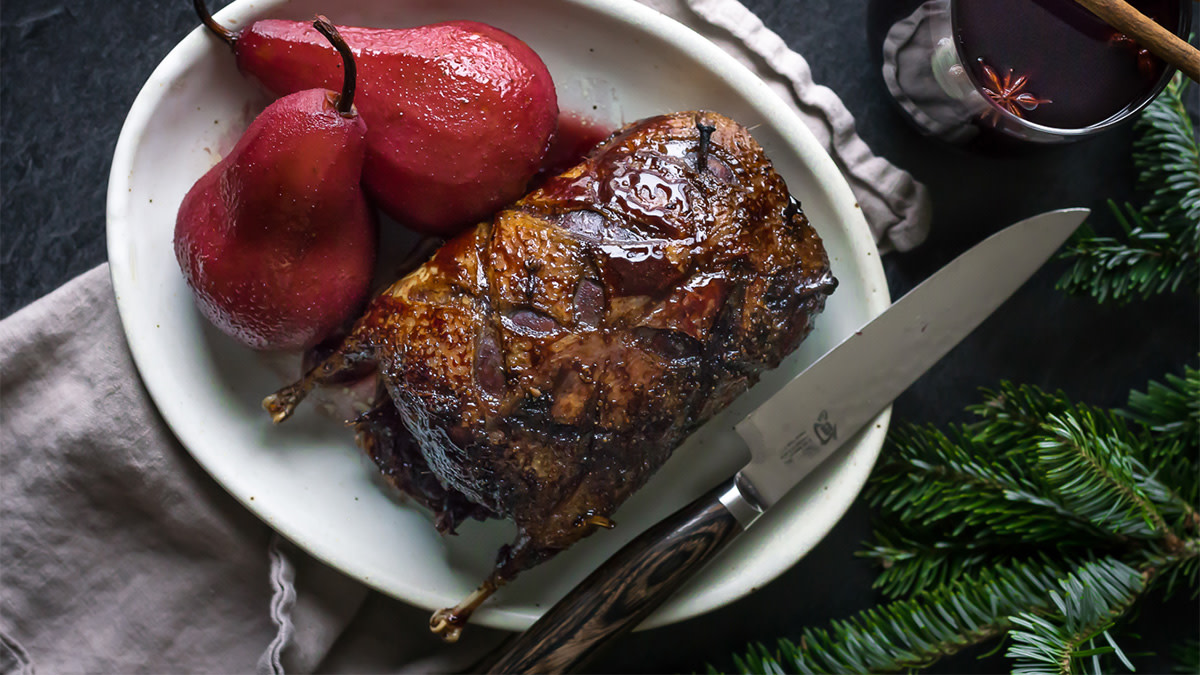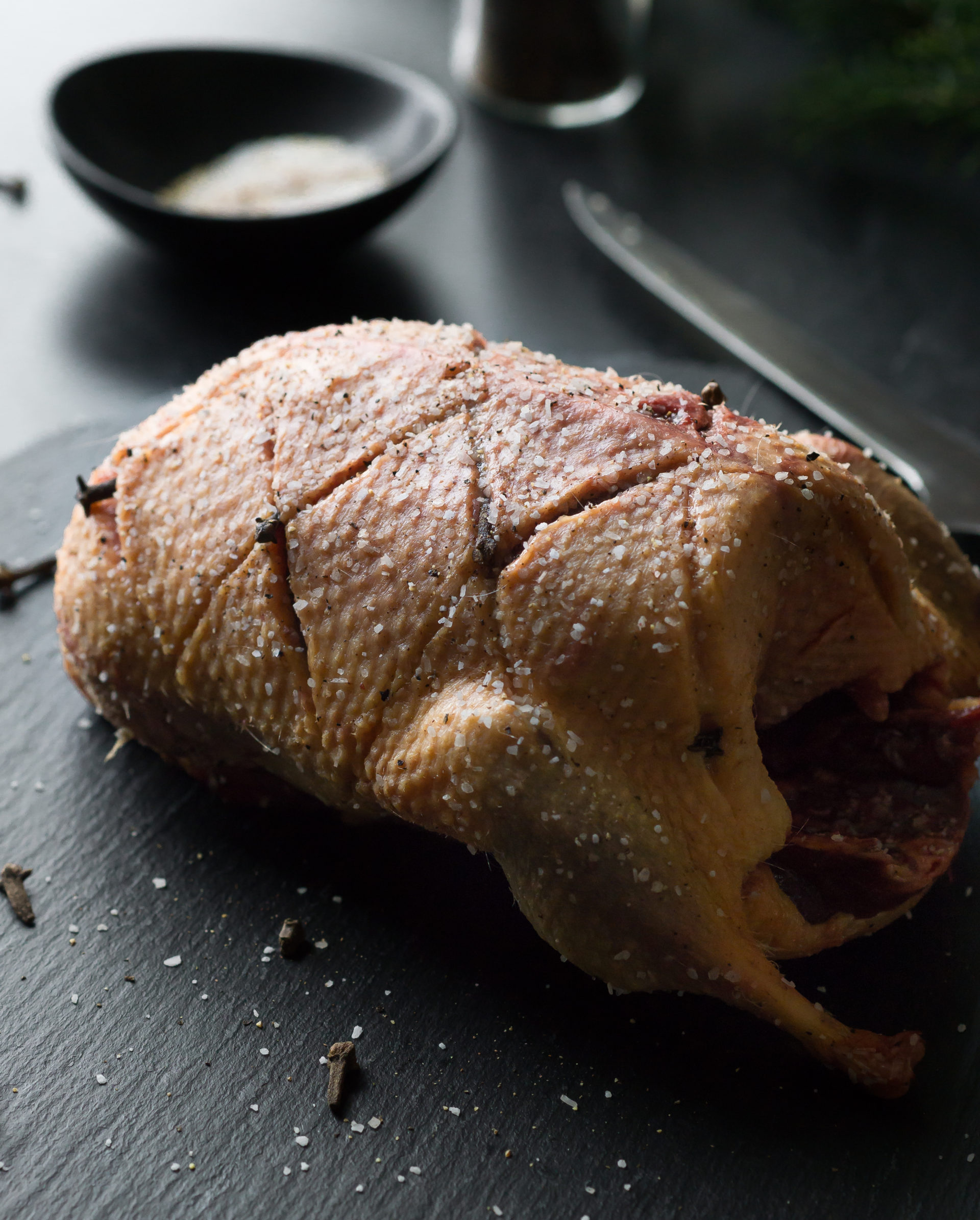
Course
Main
Duration
2 hours
Serves
4
This recipe embraces so many things that I love about the holiday season. It has become a favorite of mine. The idea began by poaching pears in mulled wine for a dessert, but when I reduced it down to a sweet glaze I knew that it belonged on the main course: roasted duck.
The mulled wine glaze is brushed across a plucked mallard while roasting in the oven. The sugars caramelize while duck fat drips down to the bed of red onions resting beneath it. The result is an unbelievable flavor combination.
The recipe is a little long but don’t let that intimidate you. It is easy to make if you just follow the tips and guidelines described below.
I like to score the skin of the duck. The purpose is to render and release the fat. The goal is to slice through the skin without cutting into the meat. This can be very hard to achieve, especially if the breast has very little fat or is full of shot. Be careful in these areas and concentrate on the parts where there is a thicker layer of fat to release.
Ingredients
- 2 medium ducks (like mallards) or 4 small ducks (like teal), plucked
- Oil or ghee for cooking
- Salt and pepper
- 4 Bosc pears
- 1 red onion, sliced
- 1 bottle red wine
- 2 cups apple cider
- 1 small orange, sliced
- 8 cloves
- 2 cinnamon sticks
- 2 star anise pods
- 1 tbsp. allspice berries
- 6 tbsp. honey
Preparation
-
Bring ducks to room temperature before cooking and pat very dry. Rub each bird with a teaspoon of ghee or oil. Season with a mixture of salt and pepper under the skin and on top of the meat.
-
Score the skin in a crosshatch pattern using a sharp knife. Gently make long incisions across the skin without piercing the meat. Place a clove into every other crosshatch mark and wedge them in between the layers of skin. Set the duck aside while you make the mulled wine and preheat the oven to 475.
-
In a medium sized pot (big enough to fit four pears), combine the wine, cider, oranges, and spices together. Turn the heat to medium-high until it begins to simmer.
-
While the wine is simmering, use a peeler and peel the skin off the pears. Place the pears in the pot with the mulled wine. Adjust the heat to a lower setting and continue to gently simmer until the pears are tender when pricked with a fork (about 25 minutes).
-
Remove the pears and set aside on a plate to keep warm.
-
Strain the mulled wine and discard the spices and oranges. Reserve a cup of the mulled wine for making the glaze. You can drink the remaining or freeze it for future use.
-
Add the cup of wine back to the pot. Turn the heat to high and add 6 tablespoons of honey. Whisk to dissolve and boil fiercely for 10 minutes, then remove from heat. The glaze should be reduced to about half a cup and will thicken into a syrup consistency as it cools.
-
Line the bottom of a cast iron skillet with a touch of oil. Spread the red onion slices across to act as a roasting rack for the ducks. Place the ducks on top and roast in the oven. A small duck, such as teal, will only need about 15 minutes to cook. A larger duck could take up to 15-25 minutes. You want to cook it until the internal temperature of the breast reaches 135 degrees for medium-rare. At this point, the legs might not be done. You can either roast the whole bird until the legs are done, resulting in a medium cooked breast, or carve the legs off and sear in a cast iron skillet to finish.
-
During the last 5 minutes of cooking, brush the mulled wine glaze over the duck and drizzle over the red onions.
-
Allow the duck to rest 5-10 minutes. Serve with the caramelized red onions and poached pears. Drizzle extra glaze over the top of everything.
Sign In or Create a Free Account
Reviews
This recipe embraces so many things that I love about the holiday season. It has become a favorite of mine. The idea began by poaching pears in mulled wine for a dessert, but when I reduced it down to a sweet glaze I knew that it belonged on the main course: roasted duck.
The mulled wine glaze is brushed across a plucked mallard while roasting in the oven. The sugars caramelize while duck fat drips down to the bed of red onions resting beneath it. The result is an unbelievable flavor combination.
The recipe is a little long but don’t let that intimidate you. It is easy to make if you just follow the tips and guidelines described below.
I like to score the skin of the duck. The purpose is to render and release the fat. The goal is to slice through the skin without cutting into the meat. This can be very hard to achieve, especially if the breast has very little fat or is full of shot. Be careful in these areas and concentrate on the parts where there is a thicker layer of fat to release.
Ingredients
- 2 medium ducks (like mallards) or 4 small ducks (like teal), plucked
- Oil or ghee for cooking
- Salt and pepper
- 4 Bosc pears
- 1 red onion, sliced
- 1 bottle red wine
- 2 cups apple cider
- 1 small orange, sliced
- 8 cloves
- 2 cinnamon sticks
- 2 star anise pods
- 1 tbsp. allspice berries
- 6 tbsp. honey
Preparation
-
Bring ducks to room temperature before cooking and pat very dry. Rub each bird with a teaspoon of ghee or oil. Season with a mixture of salt and pepper under the skin and on top of the meat.
-
Score the skin in a crosshatch pattern using a sharp knife. Gently make long incisions across the skin without piercing the meat. Place a clove into every other crosshatch mark and wedge them in between the layers of skin. Set the duck aside while you make the mulled wine and preheat the oven to 475.
-
In a medium sized pot (big enough to fit four pears), combine the wine, cider, oranges, and spices together. Turn the heat to medium-high until it begins to simmer.
-
While the wine is simmering, use a peeler and peel the skin off the pears. Place the pears in the pot with the mulled wine. Adjust the heat to a lower setting and continue to gently simmer until the pears are tender when pricked with a fork (about 25 minutes).
-
Remove the pears and set aside on a plate to keep warm.
-
Strain the mulled wine and discard the spices and oranges. Reserve a cup of the mulled wine for making the glaze. You can drink the remaining or freeze it for future use.
-
Add the cup of wine back to the pot. Turn the heat to high and add 6 tablespoons of honey. Whisk to dissolve and boil fiercely for 10 minutes, then remove from heat. The glaze should be reduced to about half a cup and will thicken into a syrup consistency as it cools.
-
Line the bottom of a cast iron skillet with a touch of oil. Spread the red onion slices across to act as a roasting rack for the ducks. Place the ducks on top and roast in the oven. A small duck, such as teal, will only need about 15 minutes to cook. A larger duck could take up to 15-25 minutes. You want to cook it until the internal temperature of the breast reaches 135 degrees for medium-rare. At this point, the legs might not be done. You can either roast the whole bird until the legs are done, resulting in a medium cooked breast, or carve the legs off and sear in a cast iron skillet to finish.
-
During the last 5 minutes of cooking, brush the mulled wine glaze over the duck and drizzle over the red onions.
-
Allow the duck to rest 5-10 minutes. Serve with the caramelized red onions and poached pears. Drizzle extra glaze over the top of everything.






